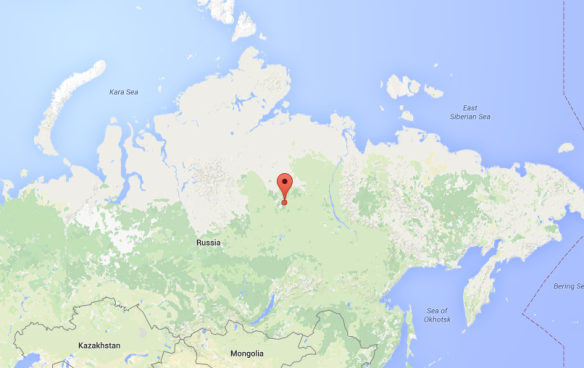December 18th, 2014
A strange red and green “Christmas Rock” teeming with 30,000 teeny diamond crystals has members of the scientific community scratching their heads.

Just over one inch wide, the host rock has a diamond density one million times higher than normal diamond-bearing ore, which typically yields 1 to 6 carats per ton, according to LiveScience.com.

Russian miners unearthed the festive-looking specimen at Alrosa’s Udachnaya diamond mine near the Arctic Circle and gifted it to the Russian Academy of Sciences.
Via X-ray tomography analysis, scientists discovered the stone is made up of 30,000 diamond octahedron crystals, which look like two pyramids fused together at the base. Each octahedron is colorless and about 1mm (.04 inches) in height.
Because of their minute size, the diamonds have no practical use in jewelry, but they present a rare and wonderful opportunity for scientists.
"The exciting thing for me is there are 30,000 itty-bitty, perfect octahedrons, and not one big diamond," said University of Tennessee geologist Larry Taylor, who presented his initial findings Monday at the American Geophysical Union's annual meeting. "It's like they formed instantaneously. This rock is a strange one indeed."
Red garnet and green olivine are responsible for giving the rock’s surface its Christmas Holiday colors. Taylor is hoping that the minerals that make up the host rock will provide critical clues about the origin of diamonds that form under intense heat and pressure about 150km (93 miles) below the earth’s surface.
Volcanic eruptions are responsible for bringing the diamond-rich mantle material to the surface, but much of the mantle rock breaks up during the perilous ride, leaving only the diamond crystals behind. In the case of the Udachnaya Christmas Rock, the mantle material stayed intact, according to LiveScience.com.
Taylor’s complete analysis of how the Christmas Rock formed will be published in the January issue of Russian Geology and Geophysics.
Rock photo: Larry Taylor; Map: Google Maps.

Just over one inch wide, the host rock has a diamond density one million times higher than normal diamond-bearing ore, which typically yields 1 to 6 carats per ton, according to LiveScience.com.

Russian miners unearthed the festive-looking specimen at Alrosa’s Udachnaya diamond mine near the Arctic Circle and gifted it to the Russian Academy of Sciences.
Via X-ray tomography analysis, scientists discovered the stone is made up of 30,000 diamond octahedron crystals, which look like two pyramids fused together at the base. Each octahedron is colorless and about 1mm (.04 inches) in height.
Because of their minute size, the diamonds have no practical use in jewelry, but they present a rare and wonderful opportunity for scientists.
"The exciting thing for me is there are 30,000 itty-bitty, perfect octahedrons, and not one big diamond," said University of Tennessee geologist Larry Taylor, who presented his initial findings Monday at the American Geophysical Union's annual meeting. "It's like they formed instantaneously. This rock is a strange one indeed."
Red garnet and green olivine are responsible for giving the rock’s surface its Christmas Holiday colors. Taylor is hoping that the minerals that make up the host rock will provide critical clues about the origin of diamonds that form under intense heat and pressure about 150km (93 miles) below the earth’s surface.
Volcanic eruptions are responsible for bringing the diamond-rich mantle material to the surface, but much of the mantle rock breaks up during the perilous ride, leaving only the diamond crystals behind. In the case of the Udachnaya Christmas Rock, the mantle material stayed intact, according to LiveScience.com.
Taylor’s complete analysis of how the Christmas Rock formed will be published in the January issue of Russian Geology and Geophysics.
Rock photo: Larry Taylor; Map: Google Maps.

